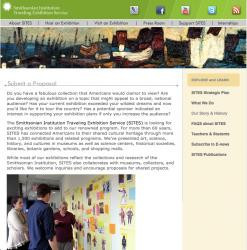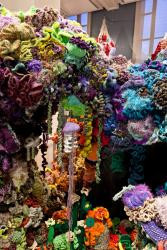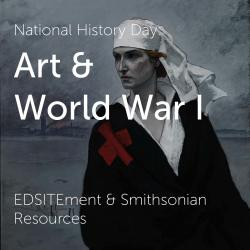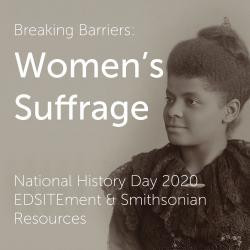Alison Leithner's collections
Women in Flight
<p>Did you know that astronaut Mae Jemison carried a picture of aviator Bessie Coleman in her uniform pocket? Or that astronaut Sally Ride was a major supporter of vice presidential candidate Geraldine Ferraro? Find out about these inspirational women and others in this collection. This topical collection is a great starting point for research about female aviators and astronauts, and includes articles, images, artifacts, and video. Some guiding questions to consider might be:<br />-Why do you think it was so challenging for female pilots to become accepted? Compare the inclusion of women in aviation to other industries and fields. <br />-What role did the military play in the growth in the number of female aviators?<br />-What connections can you find between various female pilots and astronauts?<br />-Is being the "first" of something a political act? How do many female aviation leaders use their public voice?</p>
<p>#BecauseOfHerStory<br /></p><p>Adapted from <a href="https://learninglab.si.edu/collections/let-women-fly-female-aviators-and-astronauts/TJhqi1CMfNzms2rH#r" target="_blank">"Let Women Fly": Female Aviators and Astronauts</a> by Kate Harris</p>
 Alison Leithner
Alison Leithner
34
Smithsonian and the Twenty-First Century Museum: Leadership Strategies - Week 5 Images
<p>This collection supports the Week 5 lecture for the Harvard Extension School course MUSE E-200 Smithsonian and the Twenty-First Century Museum: Leadership Strategies. This fifth lecture is titled <em>The Business of Museums.</em></p><p>The course can be found on the Harvard Extension School's Canvas site at <a href="https://canvas.harvard.edu/courses/19789">https://canvas.harvard.edu/courses/19789</a></p><p>#MUSE200 #HES</p><p><br /></p>
 Alison Leithner
Alison Leithner
11
Smithsonian and the Twenty-First Century Museum: Leadership Strategies - Week 2 Images
<p>This collection supports the Week 2 lecture for the Harvard Extension School course MUSE E-200 Smithsonian and the Twenty-First Century Museum: Leadership Strategies. This second lecture is titled <em>Institutional Leadership and Change: Smithsonian Strategic Plan and Vision.</em></p><p>The course can be found on the Harvard Extension School's Canvas site at <a href="https://canvas.harvard.edu/courses/19789">https://canvas.harvard.edu/courses/19789</a></p><p>#MUSE200 #HES</p>
 Alison Leithner
Alison Leithner
26
Smithsonian and the Twenty-First Century Museum: Leadership Strategies - Week 4 Images
<p>This collection supports the Week 2 lecture for the Harvard Extension School course MUSE E-200 Smithsonian and the Twenty-First Century Museum: Leadership Strategies. This fourth lecture is titled <em>Interdisciplinary Research and Collaboration Across an Institution. </em>The lecture features guest speaker, Liz Kirby.</p><p>The course can be found on the Harvard Extension School's Canvas site at <a href="https://canvas.harvard.edu/courses/19789">https://canvas.harvard.edu/courses/19789</a></p><p>#MUSE200 #HES</p>
 Alison Leithner
Alison Leithner
56
Correspondence: Poetry, Letters, and Postcards from the Dreier Sisters
<p>In this collection, students will read a sampling of letters written to painter Dorothea A. Dreier by three of her sisters. The letters take different forms (poetry, postcards, and traditional letter) and cover a range of topics from birthdays to daily events to political activities. Students can consider the perspective of each of the authors and then draft a response from Dorothea's perspective to one of the letters. </p>
<p>Painter Dorothea Dreier was born into a close-knit, socially progressive family based in Brooklyn, New York. One of five siblings, Dorothea's sisters Mary E. Dreier and Margaret Dreier Robins were social reformers and suffragettes, and her youngest sibling, Katherine S. Dreier was a better-known artist and cofounder of the Société Anonyme, an organization dedicated to the promotion of modern art in the United States. Margaret Dreier Robins was a founder and member of the New York Women's Trade Union League. Mary E. Dreier was involved with the New York Women's Trade Union League, serving a term as president, and served as chair of New York City's Woman Suffrage Party. Both sisters were supporters of the Progressive Party candidates. The sisters' correspondence with Dorothea, affectionately referred to as Dodo, DAD, or Dadakins, gives insight into their labor and political activities, as well as ordinary family news and events.</p>
 Alison Leithner
Alison Leithner
6
Photograph Analysis: Dorothea Lange's documentation of history through photographs
<p>In this collection, students will analyze a transcription of a letter from Dorothea Lange to painter Ben Shahn thanking him for capturing the "Biography of a Painting" in his new book. Students will then analyze several of Lange's works from the Great Depression and the incarceration of Japanese Americans during World War II and discuss the "biography of a photograph." How does the history of these photographs affect the impact they have? What elements of these photographs bring that history to life for the viewer?</p>
<p><br /></p>
 Alison Leithner
Alison Leithner
9
Portraits of James Baldwin
<p>This student activity begins with an analysis of two portraits of James Baldwin by different artists. Then, students are asked to create their own portrait of Baldwin by remixing source material from this collection. Student portraits should answer the following questions:</p>
<p>1. How do you think James Baldwin should be remembered?</p>
<p>2. What are Baldwin's contributions to American life and culture?</p>
<p>Students may need to do additional research on Baldwin and his life in order to complete this assessment. This is an opportunity for students to learn about and explore the life of a revolutionary writer who presents a unique view of the civil rights movement and status of African Americans in the United States.</p>
 Alison Leithner
Alison Leithner
25
Alma Thomas: Breaking Barriers
<p>This collection looks at the work of American artist, Alma Thomas. It provides primary sources such as paintings, transcriptions of Thomas's letters, and articles about Thomas and her work. Student can consider the question: How did abstract painter Alma Thomas break gender and racial barriers in the art world?</p>
<p>These sources are provided as inspiration for further research into topics such as American Art, U.S. History, and Women's History.</p>
<p>#NHD2020 #NHD #BecauseOfHerStory</p>
<p>Based on a <a href="https://learninglab.si.edu/collections/nhd-2020-breaking-barriers-with-american-art/GFfFjEs3uBum3gpp#r" target="_blank">National History Day 2020 collection</a> by <a href="https://learninglab.si.edu/profile/666">Phoebe Hillemann</a></p>
 Alison Leithner
Alison Leithner
15
The Fight for Citizenship Rights: A Shared Legacy
<p>This is a topical collection concerning Civil Rights activism led by African Americans and Native Americans. The collection outlines the shifting approaches to activism, the different topics focused on, and the similarities between the struggle for African American and Native American citizenship rights. </p>
<p>#CivilRights #NativeRights #WoundedKnee #SCLC #WeShallOvercome #WoundedKnee #BlackPanther #AngelaDavis #AIM</p>
 Alison Leithner
Alison Leithner
52












